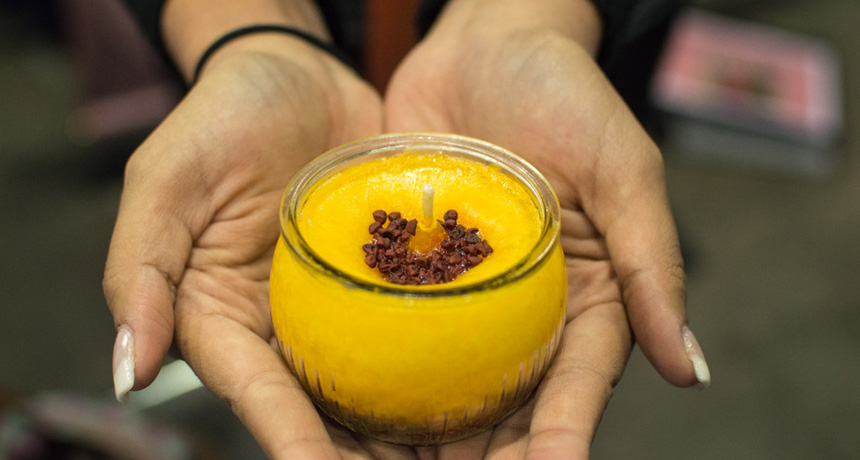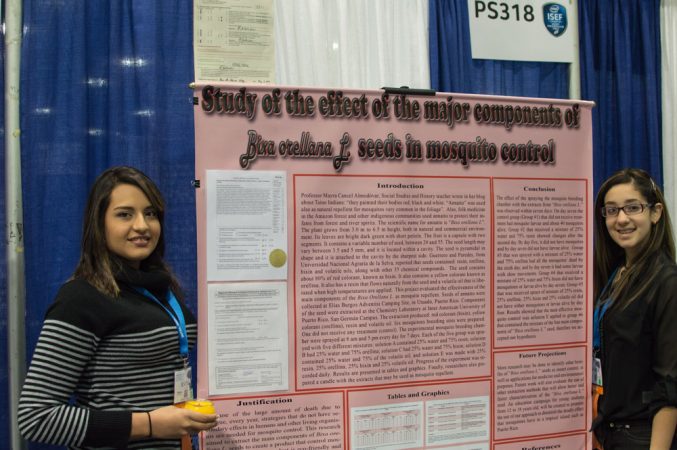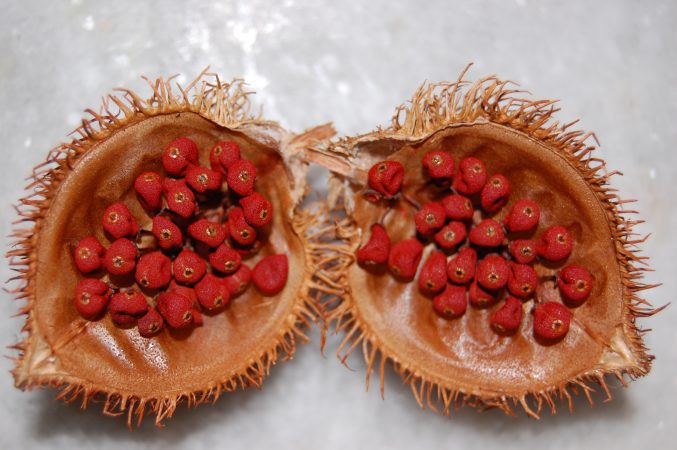Mosquitoes, be gone!
Two teens find an extract from common seeds can kill mosquito larvae and also may repel the biting adult insects

The wax in this candle includes extracts from seeds of the common plant Bixa orellana (seeds shown atop candle). Smoke from the candle can repel mosquitoes.
Patrick Thornton/SSP
By Sid Perkins
LOS ANGELES — Extracts from the seeds of a common plant can kill mosquito larvae, report two teen researchers. Smoke from a candle made with wax that includes the extracts also repels adult mosquitoes. The natural chemicals therefore show promise as an alternative to synthetic pesticides, the young scientists say.
The teens reported their findings here last week, at the Intel International Science and Engineering Fair, or Intel ISEF. The competition was created by Society for Science & the Public (which publishes Science News for Students) and is sponsored by Intel. Each year, Intel ISEF showcases some of the best high school science projects from around the globe.
Bixa orellana is a small tree or shrub found in many tropical regions in the Americas. Its bright red seeds already have many uses, says Ester Castro, 17. She’s an 11th-grader at Asuncion Rodriguez de Sala in Guayanilla, Puerto Rico. Extracts from the seeds are a popular food coloring, she notes. Powdered seeds also are part of spice mixtures used in cooking.

To separate those four main ingredients, Keren and Ester first ground the seeds. Then they used two separate procedures. In one, they added water to the mush and stirred it. From this, they skimmed off the resin and volatile oils.
They used a second process to extract the food colorings from the mush. Here, they added a mild solution of sodium hydroxide to the mush, stirred the mix and filtered it. Then they added hydrochloric acid to the liquid that had passed through the filter, and filtered it once more. The solid material that remained stuck to the second filter was bixin, says Ester. The liquid that passed through that filter contained orellina.
Once Keren and Ester had these four ingredients — the bixin, orellina, resin and volatile oils — they tested each on the swimming larvae that had hatched from mosquito eggs. The three-week-old larvae had been growing in six separate containers. At the start of the teens’ tests, each tank contained between 70 and 100 larvae.
The teens left one tank untreated. It served as a baseline. Anything that happened after the other treatments would be compared against it, Keren explains. Twice a day, the teens treated the other tanks. In four of them, the teens added one Bixa ingredient, each slightly diluted by water. (So one tank got bixin, another orellina or resin or the volatile oil.) In the last tank, they added an equal mix of all four ingredients.
For each treatment, the teens added 3 milliliters of the test solution. (That’s a little more than half a teaspoon, which usually contains about 5 milliliters.)

The extract mix also might work against adult mosquitoes, the teens report. When they added the four-ingredient cocktail to candle wax (and sprinkled a few seeds on top of the candle for good measure), smoke from the candle seemed to repel the biting insects.
Extracts from the Bixa orellana seeds could be used instead of commercial pesticides to get rid of mosquitoes, the teens suggest. Using candles scented with these natural extracts could help to scare the current generation of the pesky insects out the neighborhood. And the extracts themselves could help to kill the next generation before it takes wing.
Power words
extract A substance, often in concentrated form, that has been removed from its natural source. Extracts are often taken from plants (such as spearmint or lavender), flowers and buds (such as roses and cloves), fruit (such as lemons and oranges) or seeds and nuts (such as almonds and pistachios). Such extracts, sometimes used in cooking, often have very strong scents or flavors.
larva (plural: larvae) An immature life stage of an insect, which often has a distinctly different form as an adult.
pesticide A chemical or mix of compounds used to kill insects, rodents or other organisms harmful to cultivated plants, pet or livestock, or unwanted organisms that infest homes, offices, farm buildings and other protected structures.
resin A sticky, sometimes aromatic substance, often secreted by plants.
synthetic (as in materials) Materials created by people. Many have been developed to stand in for natural materials, such as synthetic rubber, synthetic diamond or a synthetic hormone. Some may even have the same chemical structure as the original.
volatile Chemical that easily evaporates.







